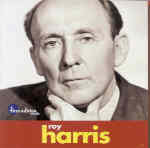The fact that I am going to move quickly over Kentucky Spring and the Fifth Symphony in order to discuss Roy Harris’ Violin Concerto in some detail does not mean that these are in any way unworthy or inferior works. The former is a lovely pastoral sketch dating from exactly the same period as Copland’s more famous Appalachian Spring and so forms an interesting contrast to that great work, while the symphony (written in 1942) is an impressively cogent wartime work with a powerful central funeral march surrounded by a vigorous opening and an emotionally ambivalent close that manages at last a typically emphatic final triumph. Both are well performed and recorded (Kentucky Spring in very clear mono, the Symphony in very good 1965 stereo).
But Harris’ Violin Concerto (1949) is a genuine masterpiece that the composer didn’t live to hear performed, which is why this 1985 premiere recording by Gregory Fulkerson (who also gave the first public rendering of the work in 1984) is so important. The reason the piece wasn’t performed earlier is sad: it was commissioned for Cleveland Orchestra concertmaster Joseph Gingold, but when it came time for the premiere the parts were full of mistakes that could not be corrected in time, and so the performance was cancelled, and that was that–a sorry fate for such an impressive and truly individual piece that shows the composer working at the very top of his form. For my money, this is a far more impressive piece than, say, Barber’s delightful and deservedly popular concerto, and it strikes me as standing an excellent chance of making a strong impression in concert.
Harris has a reputation today of being a somewhat “simplistic” composer, both in terms of his resolutely optimistic musical philosophy as well as his orchestral technique. It’s very interesting to see how such a composer, known for his stentorian brass writing and heavy-duty percussion, adapts to the problem of accompanying a solo violin. The answer: He does it with extraordinary finesse. Harris structures his concerto in four linked sections, a sort of gigantic “theme and variations” lasting nearly half an hour. In the beginning, after a whirlwind opening, the violin spins out a seemingly endless melody, gently accompanied by the orchestra. A lengthy and vigorous allegro of markedly dance-like character follows, proceeding to an extended cadenza.
From this point on the music returns to its original slow tempo, but as the orchestra gathers the various melodic strands together the solo embroiders the texture with ever more elaborate and ornamental variations, reaching the sort of lyrical ecstasy typical of, say, Tippett’s most complex string textures (as perhaps in the Corelli Variations or Second Symphony). It’s difficult to describe the luminous orchestration and exalted tone that Harris achieves, without (I should add) any roof-raising brass or thudding bass drum volleys. There’s really nothing like it in the entire modern violin repertoire, and for something similar you would have to go back in time to the wilder inspirations of Biber and the early German Baroque violin school.
Gregory Fulkerson plays every note as though he understands the music’s greatness (the closing pages are especially stunning), and he’s very well accompanied by Lawrence Leighton Smith and the Louisville Orchestra. The recording offers perfect balances between orchestra and solo, though much of the credit also belongs to the composer for fashioning such a sophisticated and apt accompaniment. The rating, then, applies to this work (though as I said the rest is very good too), and while it’s always dangerous to give the highest accolades to a single performance of a work with no performance tradition, its importance is such that the music truly deserves the strongest possible advocacy. [6/28/2003]
































